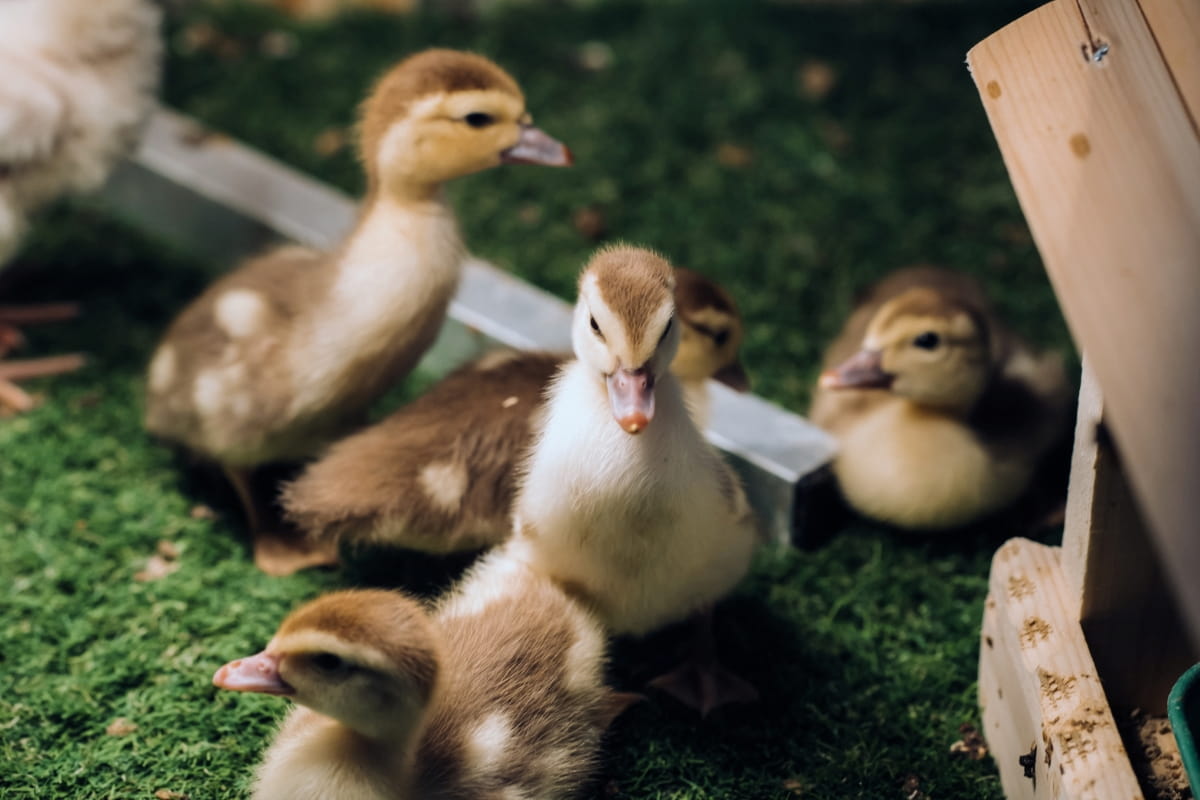A rich history of the Saxony duck breed dates back to the early 20th century when it was developed in Germany. It was created by Albert Franz with the intention of producing both a meat-producing and egg-laying duck. A combination of Rouen, Pekin, and Blue Pomeranian ducks was used to create the breed.

Physical Appearance and Plumage of Saxony Ducks
With its large head and slightly arched forward neck, its oval-shaped head blends smoothly with its medium-thick neck. Its compact body is long and broad across its shoulders, and its chest is rounded and prominent. When relaxed, this duck’s carriage is 10-20 degrees above horizontal. They display the typical “Mallard” pattern, but their colors are different from those of any other breed. Blue-gray markings are found on the drake’s head, back, and wings.
There is a rich chestnut-burgundy color on the breast feathers, a cream color on the underbody and flanks, and a white color on the neck ring. There are orange or reddish-brown legs and feet and a yellow or orange bill often striped with pale green. They have white facial stripes and neck rings on the females, and their underbodies are cream-colored. Often, the bill is orange with brown shading. Legs and feet are orange to reddish-orange.
Temperament and Behavior of Saxony Duck Breed
- Ducklings from Saxony are naturally curious and fearless. It is also wonderful and interesting to watch the adults.
- Are Saxony ducks friendly? They are friendly and gentle but can be loud when food is involved.
- Are Saxony ducks noisy? They may nip at your feet, reminding you to feed them right away. However, they are not aggressive.
- Their flightiness makes them easier to handle and train than other duck breeds.
- In addition to their calm and peaceful demeanor, Saxony ducks are also well suited for backyard or small-scale farming.
- The Saxony duck is docile and lively at the same time. Playing with them will be enjoyable for even young children.
- Because they quack less and are calmer than other duck breeds, Saxony drakes are more hassle-free and easygoing.
- In contrast, the hens are loud and easily agitated.
Saxony Duck Size and Saxony Duck Egg Color
Saxony duck size: At maturity, the Saxony weighs between 3.8-4.3 Kg. There is a prominent chest that is smooth, and the compact body is long and broad across the shoulders. When relaxed, this duck’s carriage is 10-20 degrees above horizontal. The gene for protoporphyrin IX, the pigment responsible for brown eggs, causes many ducks to lay brown eggs. Due to the lack of this gene, Saxony ducks lay white eggs. Due to impurities in calcium carbonate used for making eggshells, some Saxony ducks may lay green or blue eggs.
Saxony Duck’s Diet and Feeding Requirements
Given enough space to forage, these ducks will find most of the healthy food they need. Ponds and lakes provide various grasses, weeds, berries, insects, and protein sources. Cracked corn, peas, cucumbers, and tomatoes, and a wide variety of fresh snacks are also enjoyed by them. As with other ducks, they need the grit to digest their food. There should also be access to clean drinking water. Water consumption by ducks varies depending on environmental conditions, but they typically consume 60-120 ml daily.
Feeding
Purchasing and using high-quality duck food from a reputable pet store is the best way to ensure your ducks get the proper nutrition. Aside from pellets, this food should include chopped vegetables and fruit, as well as some grit to aid digestion. Providing crushed oyster shells or eggshells with their feed is also helpful when chickens reach the laying age. The material will aid hens in forming strong eggshells when it is time to lay eggs.
In case you missed it: Muscovy Duck Facts: Eggs Laying, Care Guide, and More

Housing and Space Requirements for Saxony Ducks
A chicken coop can also be used to house ducks. There is a need for shelter against the frost in winter. On hot summer days, Saxony ducks also enjoy shaded areas and access to ponds and pools. Since they don’t roost like chickens, they prefer sleeping on the ground and not requiring nest boxes. Burrowing into their bedding and lining it with feathers is what they’ll do.
It is necessary for duck sheds to be spacious enough to provide them with about 10 square feet of space per duck. Chickens and Saxony ducks can be housed together. The Saxony duck does not require a pair to be kept, but other ducks are needed to keep them company. In addition, you should maintain a good drake-to-hen ratio.
Breeding and Reproduction of Saxony Ducks
It is important to create an environment that mimics the natural habitat of Saxony ducks when breeding them. For successful breeding, it is crucial to have a proper diet, plenty of water, and an appropriate shelter. Ducks of this type are known to be good layers, with females typically laying around 190-200 eggs yearly.
It takes approximately 28 days for the ducklings to hatch, and they will need a warm and safe brooder until they are old enough to join their flock. A hen will begin laying after about 25 weeks of age, and in the laying season, between mid-March and early July, she will lay approximately once every two to three days. There can be up to 15 eggs in a clutch on average.
Common Diseases in Saxony Ducks: Prevention and Treatment
Respiratory Infections: If Saxony Ducks live in damp or dirty areas with poor air quality, respiratory infections can also be a serious health issue. There are several symptoms to watch out for, including wheezing, labored breathing, and nasal or eye discharge. If your duck displays any of these symptoms, you should immediately take it to a veterinarian for a diagnosis and treatment.
Vaccinations and Wormers: Immunizations and wormers are great ways to prevent your flock from contracting specific illnesses. Most states require that show or breeding birds be vaccinated, so vaccinating below even recreational level shows is a good idea unless advised otherwise by a veterinarian. Deworming adults and young ducks every 5-6 weeks until they are 20-25 weeks old is recommended, but it also depends on the situation, which should be discussed with a veterinarian.
Saxony Duck’s Egg Production and Incubation
Throughout the year, these ducks lay many large, white eggs. Around 180 to 220 eggs can be laid by a Saxony duck each year. Due to their egg-laying ability and produce flavorful meat, they are considered one of the best dual-purpose duck breeds. A Saxony duck is dedicated and attentive when it comes to incubation.
In case you missed it: Frequently Asked Questions About Duck Farming

Known for being successful hatchers, they have an instinct for incubating eggs. It takes about 28 days for Saxony ducks’ eggs to hatch properly when given the right care and conditions. Saxony ducks are an excellent choice for folks who want to raise ducks to produce eggs and incubate eggs.
Conclusion
Raising Saxony Ducks is a rewarding experience. Watching the ducks thrive in their ideal environment is truly amazing and freeing. As long as you know what it takes to raise healthy and happy Saxony ducks, you will have great success from day one.
- Feed Your Flock for Less: Top 10 Tips to Save on Chicken Feed
- Ultimate Guide to Ossabaw Island Hog: Breeding, Raising, Diet, and Care
- Hatching Answers: The Top 10 Reasons Your Chickens Aren’t Laying Eggs
- Eggs and Economics: Breaking Down the Cost of Raising Backyard Chickens
- Defend Your Greens: Proven Methods to Keep Iguanas Out of Your Garden
- Ultimate Guide to Cinnamon Queen Chicken: A Comprehensive Guide for Beginners
- Ultimate Guide to California Tan Chicken: Breeding, Raising, Diet, Egg-Production and Care
- Ultimate Guide to Marsh Daisy Chicken: Breeding, Raising, Diet, and Care
- 10 Types of Chicken Farming Businesses You Can Start for Profits